
-
2025
-
2024
-
2023
-
2022
-
2021
-
2020
-
2019
-
2018
-
2017
-
2016
-
2015
-
2014
-
2013
-
2012
-
2011
-
2010
-
2009
-
2008
-
2007
-
2006
-
2005
-
2004
-
2003
-
2002
- 2001
-
2000
-
1999
-
1998
-
1997
-
1996
-
1995
-
1994
-
1993
-
1992
-
1991
-
1990
-
1989
-
1988
-
1987
-
1986
-
1985
-
1984
-
1983
-
1982
-
1981
-
1980
-
1979
-
1978
-
1977
-
1976
-
1975
-
1974
-
1973
-
1972
-
1971
-
1970
-
1969
-
1968
-
1966
-
1964
-
1963
-
1961
-
1959
-
1958
-
1955
-
1954
-
1953
-
1952
-
1951
-
1950
-
1949
-
1948
-
1947
Abstract: Modern travertine deposits are observed in the Sıcakçermik hot springs area located northwest of Sivas, Central Anatolia.They are the carbonate deposits of crustal (spongy) and/or alabaster-textured formations controlled by both organic (the fissure and joint ridges) and inorganic (waterfall or cascade deposits; terrace-mound travertines; and shallow lake fans)processes. They are recognized in the field by special identifying trails such as manganous-ferrous travertine shrubs resembling ivy, siliceous stromatolites, and ferrous pisoids, 3 to 12 mm in diameter.All the recent travertine samples examined dominantly consist of subidiomorphic prismatic-tabular calcite crystals.Scanning Electron Microscopy (SEM) revealed that calcite crystals forming the pisoids are characterized by zonal growth.Stromatolitic formations, on the other hand, bear regular joints developed as a consequence of sudden cooling and some special structures indicative of bacterial activity (in the form of nodule, spheroid, ellipsoid, column, filament and honeycomb orgrape bunch structures). In addition, secondary dissolution vugs and pores giving way to the release of CO2 are associatedstructures with the stromatolitic formations. From stable isotope analyses of the different type travertines 8 I3C values between6.95 and 8.09 %o, and bl80 values between -15.73 and -16.76 %o were obtained.The data collected through all the utilized techniques suggest that the microbiological activities are dominanatly effectivein the formation travertines. It was concluded that travertines were produced by microorganisms referred to as in literaturesulfate-reducing, boring-budding bacteria such as Coccoids, Pedomicrobium, Beggiatoa sp., Thiobacillus sp as well as bluegreen algae (Cyanobacteria). On the other hand, the stable isotope data indicate that water of the hot y ^ is of meteoricorigin and carbonate sediments are accumulated in few 10 years.
Abstract: In this study, a total of 300 samples either collected from 13 measured sections or as spot sample from 7 stratigraphic horizons have been investigated for their ostracoda assemblages. 22 species, 11 of which already known, eight yet unnamed, 2new species and 1 new subspecies belonging to 8 brackish and freshwater genera have been identified.Five different ostracoda biozones have been recognized considering the stratigraphic and geographic distribution of ostracoda fauna in the measured sections. These are from bottom to top: Zone AI- Cyprideis pannonica-Cyprideis torosa Zone, ZoneAll- Limnocythere sp.l-Paralimnocythere sp. 2 Zone, Zone Alll-Cyprideis sp.l Zone, Zone AIV-Cyprideis tuberculataCyprinotus salinus Zone and Zone AV-Xestoleberis sp.-Cyprideis sublittorallis Zone. Zones AI, All, AIII and AIV are characterized in the Pannonian stage but Zone V in the Pontian stage.The results are both correlated and supported with the other fauna and flora groups (benthic foraminifera, microvertebrate,microgastropoda, spors and pollens) which confirm the identification and separation of Pannonian (Early, Middle, Late) andPontian stages in the studied material.
Abstract: Dolomites (Ballikay a formation) exposed in the Triassic succession of Kocaeli Peninsula are 15-25 m. thick The dolomiteswere formed on a transition area between slope and basin. They consist of two different types as matrix and cementationdolomites. Stable isotope values obtained from those are 8I8O = -5.18 - -6.10 %o; SUC= 1.49 - 2.81 %o . The isotopic datasuggest that an environmental change took place during dolomitization, which ranged from fresh-seawater mixing zone toshallow burial realm. On the other hand, dolomitization temperature calculated as 36-41 C indicates that the dolomites hadnot suffered from deep burial diagenesis.
Abstract: In this study, macro and micro ore textures within the metamorphic rocks around the granites of Akdağmadeni Pb-Zndeposite to the east of Akdağmadeni district are presented. In the previous studies the ores were interpreted as a simple skarntype related to granites. However, in this study it is concluded that the Akdağmadeni lead-zinc deposit can be interpreted notonly as skarn types but also as metamorphic types on the basis geologic, petrographic, mineralogic and structural-texturalproperties. Therefore, it is postulated that the Akdağmadeni lead-zinc deposite is a complex deposit in which features and / oreffects of both regional and contact metamorphism are observed, rather than being a simple skarn type deposit as revealedby previous studies on the basis of the presence of granite.

 TMMOB
TMMOB